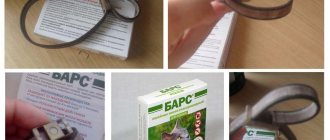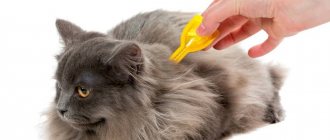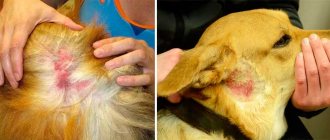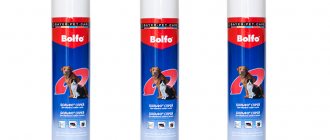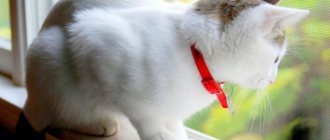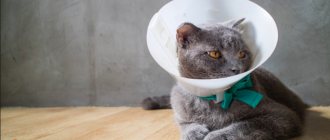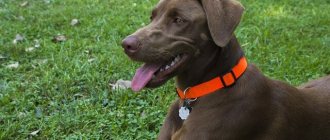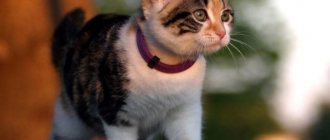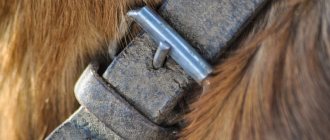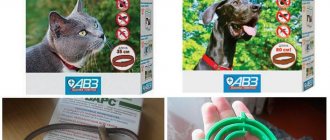produces protective products for pets. A wide range of products allows you to choose the right product, taking into account the age and size of your pet.
A series of flea collars is represented by several varieties, which differ in the active substance, length, and the presence of contraindications.
Active components and active substance
The inner side of the polymer tape is impregnated with a special composition that has protective properties that have an insecticidal effect. The active substances are carefully selected, so penetration into the animal’s circulatory system and changes in its composition are completely excluded.
Collar
Cat and dog collars have the following active ingredients:
- permethrin;
- diazinon;
- citronella oil;
- pine scent.
Attention! To avoid the penetration of active components into the body, when working with the collar, you should follow the rules of personal hygiene.
Auxiliary components are:
- chalk;
- tribasic lead sulfate;
- diphthalate (DOP);
- titanium dioxide;
- soybean epoxy oil;
- calcium stearate.
Celandine collar with permethrin
Black polymer tape 50 cm long, treated from the inside with the active ingredient permethrin 5 percent concentration. Additionally, the protective agent has a pine fragrance and auxiliary substances.
Actively protects pets from fleas, lice, lice for 120 days, and from ixodid ticks - 90 days.
Collar with diazinon
Celandine Plus - black or blue polymer tape 35-40 cm long for cats, 65 cm for dogs. The protective agent is treated from the inside with 10% concentration of diazinon. Auxiliary components increase the effectiveness of the active substance.
Evenly distributed throughout the epidermis, diazinon paralyzes fleas and ticks, causing them to die. The active substance reaches its working concentration 24-48 hours after putting on the collar.
The effectiveness of combating ticks lasts 90 days, fleas, lice, lice - 120.
Bio collar
You can use polymer tape impregnated with citronella oil on the inside to protect pets older than 4 weeks. A special feature of this type of protective collar is the absence of insecticides, so the product can be used by pregnant, lactating, sick, weakened cats and dogs. The product has a unique smell and repels parasites well.
Collars for puppies and kittens
Celandine collar
For small pets over 8 weeks The Celandine brand produces protective accessories Junior. The length of the polymer tape is 35 cm. The composition includes citronella oil, binders and active components: permethrin 1% and fipronil 5%. Insecticides do not penetrate the blood and do not change its qualitative composition. They are safe for animals, but have a destructive effect on lice, fleas, ticks, and lice-eaters in dogs and cats.
Side effects may occur if the animal has an individual intolerance to the components of the drug. If a cat or dog develops excessive salivation, muscle tremors, or lacrimation, the collar should be removed immediately. You can look at other types of collars for cats and dogs, and also learn how to put them on correctly. There are special collars for kittens.
Operating principle
Once put on, the Celandine flea collar begins to act actively. Permethrin, diazinon, citronella oil or pine fragrance, which is the main active ingredient, is gradually released from the surface. The product remains on the scalp without being absorbed into the systemic bloodstream. Places where active components accumulate:
- epidermis;
- hair follicles;
- sebaceous glands.
Protected!
The product has a long-lasting, contact effect, is well tolerated, non-toxic, and does not irritate the areas adjacent to the skin. Protects the animal from ixodid ticks, fleas, lice, lice.
Celandine in the collar - fact or fiction
The herb celandine has a number of beneficial properties and is widely used in folk medicine. It cleanses the skin of acne, warts, and promotes wound healing. But the plant does not have any destructive or repellent effect on parasites. Therefore, no company produces a flea collar with celandine for dogs and cats. It is also worth considering that the medicinal plant, despite its healing power, is a poisonous herb.
Collar Celandine
Enterprising people took advantage of the resulting confusion and new product positions appeared in some online stores, including a flea and tick collar for cats with celandine, drops for withers with extract. Don't be fooled and remember that there are no certified protective accessories containing celandine.
Review
A friend advised me to buy a Celandine biocollar for my cat. I only remembered the name of the herb and started looking in pet stores for a flea collar with celandine for cats. I had no time to read reviews and so I persistently searched for just such an accessory in veterinary pharmacies. It’s good that in one of the stores the seller explained everything to me clearly. This is what it means to not listen carefully to the advice of your friends.
Svetlana, Moscow
Instructions for use
Use polymer tape to destroy and protect pets from parasites:
- fleas;
- lice;
- lice eaters;
- ixodid ticks.
Let's take a closer look at how to put on the Celandine collar:
- open the cardboard package;
- read the instructions carefully;
- tear the plastic film;
- spread the polymer tape to the size of the animal’s head or completely unfasten it;
- putting it on the neck, adjust the size;
- fix the free edge;
- cut off excess tape.
On a note! The distance between the neck and the collar should remain 1-1.5 cm.
Constant wearing protects your pet from ixodid ticks for 3 months and insects for 4 months. The maximum effect of the polymer tape is achieved if you put it on a couple of days before the expected contact with parasites.
It is recommended to pre-treat an animal infected with a large number of insects with an insecticidal agent. The same should be done with the pet’s permanent resting place, toys, and bedding.
There were no overdose symptoms when using the Celandine collar, nor any contraindications. Violation of wearing time leads to a decrease in efficiency.
It is prohibited to use some types of Celandine collars for cats and dogs with infectious diseases, recovering, lactating and pregnant.
A collar will help rid your cat of parasites
In more advanced cases, when parasites have managed to create an entire “army” of blood-sucking creatures, veterinarians recommend using drops in combination with a collar. Its smell, which will be constantly present on the cat’s body, will have a negative impact not only on established parasites, but will also scare away potential “newcomers.”
Cat breeders who have tried this device on their pets note that on average they have to wear it for about 2-3 months. For adult cats and kittens, there are different models and sizes of the Celandine collar.
Advantages and disadvantages
The flea collar for cats Celandine has a number of advantages:
- ease of use;
- no need for regular processing;
- reliable protection;
- duration of operation;
- acceptable price.
A good choice
The disadvantages of some types of polymer tape Celandine are contraindications, limiting the range of animals that can wear this protection.
Contraindications
The anti-flea collar of the “Clandestine” series is prohibited from being used on sick or weakened animals, as well as puppies and kittens younger than the age specified in the instructions. The collar should not be used simultaneously with any other insectoacaricidal preparations.
It is extremely rare to observe cases of individual intolerance of an animal to the active component of the anti-flea drug, which can provoke individual reactions in the form of excessive salivation, lacrimation, and skin irritation.
Storage conditions
The shelf life of any type of polymer tape is 3 years, subject to the storage requirements recommended by the manufacturer. After the expiration date, the product must not be used and must be disposed of in accordance with legal requirements.
The storage location for the collar should be:
- dry;
- well ventilated;
- no direct sunlight;
- inaccessible to children;
- separately from feed;
- warm (0-30 degrees).
Product advantages
The “Clandestine” biocollar, used in accordance with the instructions, does not cause resorptive-toxic, skin-irritating or sensitizing effects on the animal’s body. The flea biocollar is approved for use on sick or weakened animals, and can also be used on pregnant and lactating females.
Anti-flea bio-collar “Clandestine” can be used in pregnant and lactating females
Additionally, a collar is a safer form of flea treatment than drops, sprays, and shampoos. The comfortable shape of the collar does not cause any discomfort in the animal. Clear and detailed instructions are supplied by the manufacturer with each product sold.
How to tell if a cat has fleas
Each flea is small in size - 2-3 mm, and drinks little blood. The danger of infection by these insects is that they multiply quickly. A large number of parasites causes serious discomfort to the cat. They can cause the development of anemia, dermatitis, and allergic reactions. They carry worms and serious infectious diseases. Due to constant itching, the pet becomes irritable, and scratching the skin can cause infection.
Flea infection is especially dangerous for kittens and animals with weak immune systems. When there are a lot of insects, they can even bite a person. Therefore, you need to know what symptoms you can use to understand that your cat has fleas:
- the pet has become restless, irritable, and aggressive;
- his appetite decreased, he began to sleep poorly;
- often itches, licks itself intensively, rubs against the floor and walls;
- irritation or an allergic reaction appears on the skin;
- you can notice red spots, scratches, bleeding wounds;
- The condition of the fur has worsened: it has become dull and falls out.
How to check a cat
To understand that a cat's behavior change is caused by flea infestation and not by other insects or diseases, you need to examine it. Use your hands or a comb to part the fur, examining the skin. When infested with fleas, not only wounds and red spots on the fur will be noticeable, you can detect the insects themselves and traces of their vital activity. These are black dots, light small eggs.
You can place your pet on a white sheet or towel and comb the fur well with a fine comb and slicker brush. Black dots and the insects themselves will be immediately visible on white. To distinguish flea excrement from ordinary dirt, you need to slightly wet it. They will turn brown or red because they contain blood.
How can a domestic cat become infected with fleas?
Some owners believe that if a pet does not go outside, then it cannot have fleas. But parasites often appear in domestic cats. These insects reproduce quickly, live at temperatures of 20-30 ° C, but during the cold season they settle in the basements of houses. The risk of infection is especially high if the cat lives in a rural area. But she can also become infected in the city. How do insects get on a cat's fur?
- from other pets, usually from dogs that walk outside;
- from mice, rats, even pigeons that fly to the balcony where the cat likes to sit;
- enter from the entrance when opening the door to the apartment, through ventilation or cracks from neighbors;
- brought on the shoes or clothes of people from the street.
Celandine collar against fleas and ticks for cats house (Code: 3811)
Celandine flea collar for cats (house) C203
I. General information
Trade name of the drug: Chistotel collar. International nonproprietary name: permethrin.
Dosage form: polymer tape. The celandine collar contains permethrin as an active ingredient - 5%, and as excipients PVC - S-70-59-M, chalk, di-(2-ethylhexyl)-phthalate (DOP), epoxidized soybean oil, pine fragrance, stearate calcium, tribasic lead sulfate and titanium dioxide.
In appearance it is a black polymer tape with a lock. The shelf life of the drug, subject to storage conditions, is 3 years from the date of production. It is prohibited to use Celandine collar after the expiration date.
The celandine collar is produced 50 cm long in individual hermetically sealed plastic bags placed individually in cardboard packs along with instructions for use.
Store the collar in the manufacturer's sealed packaging in a dry place, protected from direct sunlight, separately from food and feed at a temperature of 0°C to 30°C in places inaccessible to children.
Unused medicinal product is disposed of in accordance with legal requirements.
Conditions of release: without a veterinarian's prescription.
II. Pharmacological properties
Pharmacological group - insectoacaricidal agent. Permethrin, which is part of the collar, is gradually released from the surface of the tape, transferred to the skin and hair of the animal, without being absorbed into the systemic bloodstream, accumulates in the epidermis, hair follicles and sebaceous glands and has a long-term contact insectoacaricidal effect on insects and ixodid ticks parasitizing on dogs and cats.
Celandine collar is well tolerated by dogs and cats and does not have locally irritating or resorptive toxic properties.
III. Application procedure
Celandine collar is used to destroy fleas, lice, lice and ixodid ticks that parasitize dogs and cats, especially in the warm season (during periods of increased parasite activity).
Celandine collar should not be used by patients with infectious diseases and convalescent animals, lactating and pregnant females, puppies and kittens under 4 months of age, as well as those with increased individual sensitivity of animals to the components of the drug.
After opening the package, the collar is unrolled and put on the animal, adjusted in size so that there is a gap of 1.0-1.5 cm between the animal’s neck and the collar, then it is secured with a retainer and the excess tape is cut off.
Constantly wearing a Celandine collar provides protection for dogs and cats from ixodid ticks for 3 months, and from insects for 4 months.
To achieve maximum effect, it is recommended to put the collar on the animal 2-3 days before the expected contact with parasites. If the animal is heavily infested with insects, before using the Celandine collar, it is advisable to wash the animal with an insecticidal shampoo and treat the bedding with an insecticidal agent in accordance with the instructions for use.
No overdose symptoms have been identified when using the drug. The specifics of the action when starting to wear the collar and when removing it have not been established.
The celandine collar is not used for lactating and pregnant females, puppies and kittens under 4 months of age. Violations of the collar's use should be avoided, as this may lead to a decrease in its effectiveness.
As a rule, there are no side effects or complications when using the Celandine collar in accordance with these instructions. If the animal has increased individual sensitivity to permethrin, individual reactions are possible (excessive salivation, lacrimation, signs of skin irritation), in these cases the collar is removed, the animal is washed with soap and the fur is rinsed with plenty of running water, and if necessary, antihistamines and symptomatic agents are prescribed.
It should not be used simultaneously with other insectoacaricidal drugs.
The celandine collar is not intended for use in productive animals.
IV. Personal prevention measures
When working with the Celandine collar, you should follow the general rules of personal hygiene and safety precautions provided for when working with medicines. Smoking, drinking and eating are prohibited during work. After finishing work, wash your hands with warm water and soap. An animal with a Celandine collar should not be allowed near small children. In case of accidental contact of the drug with the skin or mucous membranes of the eyes, they must be rinsed with plenty of water. People with hypersensitivity to the components of the drug should avoid direct contact with the Celandine collar. If allergic reactions occur or if the drug accidentally enters the human body, you should immediately contact a medical facility (bring with you the instructions for using the drug or the label).
Name of the drug manufacturer and address of the production site: CJSC Nauchno-Proizvodstvennaya; Moscow region, Lyubertsy district, Tomilino village, st. Garshina, 11. Name, address of the organization authorized by the holder or owner of the registration certificate of the medicinal product to accept claims from the consumer: JSC “Scientific and Production; Moscow region, Lyubertsy district, Tomilino village, st. Garshina, 11.
